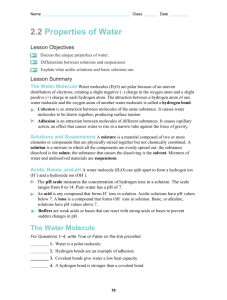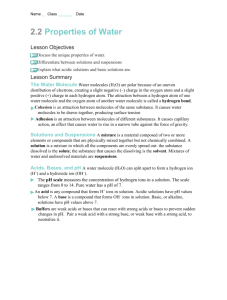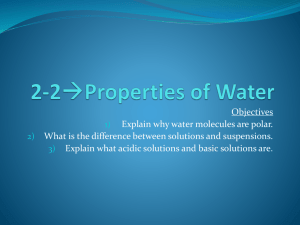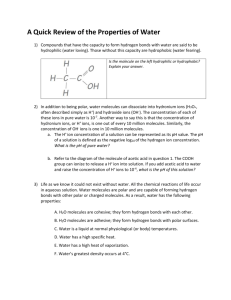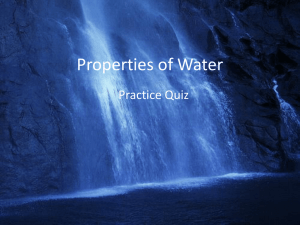2-2 PowerPoint Notes properties of water
advertisement
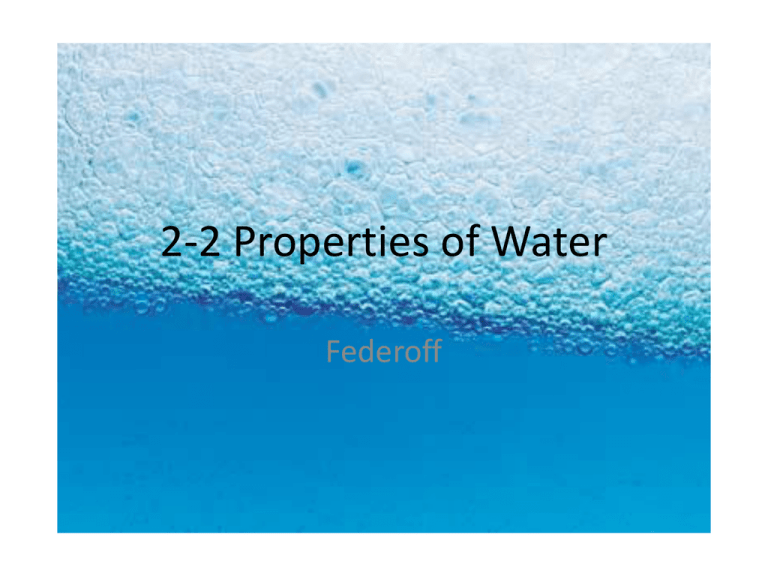
2-2 Properties of Water Federoff The Water Molecule • Water is one of the only few compounds that naturally occur as a liquid • Polarity – Oxygen’s 8 protons vs. Hydrogen’s 1 proton = Oxygen with a greater pull on electrons – So, the Oxygen end is slightly negative and Hydrogen slightly positive – “Polar” molecules behave like poles of magnets The Water Molecule • Hydrogen Bonding - The attraction between a hydrogen atom on one molecule and the oxygen atom of another – Because water is a polar molecule, it is able to form multiple hydrogen bonds, which account for many of water’s special properties. The Water Molecule – Cohesion – an attraction between molecules of the same substance. • Ex: Surface Tension – Adhesion – an attraction between molecules of different substances. • Ex: Water meniscus • Ex: Capillary Action The Water Molecule – Heat Capacity • It takes a large amount of energy to have water molecules move faster to raise the temperature of water • Ex: Ocean temperature • Ex: Cell Processes Solutions and Suspensions • Mixture – is a material composed of two or more elements or compounds that are physically mixed together but not chemically combined. – Ex: Saline Solutions Solutions and Suspensions • Solutions – a mixture in which all materials are evenly distributed throughout the solution. – Solute – The substance dissolved – Solvent – The substance in which the solute dissolves – Water’s polarity gives it the ability to dissolve both ionic compounds and other polar molecules. – Water is the universal solvent with some limitations – Ex: Salt Water Solutions and Suspensions • Suspensions – mixtures of water and nondissolved material – Ex: Human Blood Acid, Base, pH • Water does split apart into ions every 1 in 550 million molecules • Remember though, the number of H+ ions is equal to OH- ions therefore water is neutral Acid, Base, pH • The pH Scale – a system of measurement that indicates the concentration of H+ ions in a solution. – Ranges from 0-14 – 7 is neutral (equal H+ and OH) – <7 Acidic (more H+ than OH-) – >7 Basic (more OH- than H+) – Each step represents a factor of 10 Acid, Base, pH • Acid – a compound that forms H+ ions in a solution. – Ex: Hydrochloric acid for stomach digestion • Base – a compound that produces hydroxide (OH-) ions in a solution. – Ex: Lye (NaOH – Sodium Hydroxide) for soap making Acid, Base, pH • Buffer – a weak acid or base that can react with strong acids or bases to prevent sharp, sudden changes in pH. – The human body needs to maintain a pH of a 6.5 to 7.5 to maintain homeostasis – Buffers dissolved in life’s fluids play and important role in maintain homeostasis in organisms.


